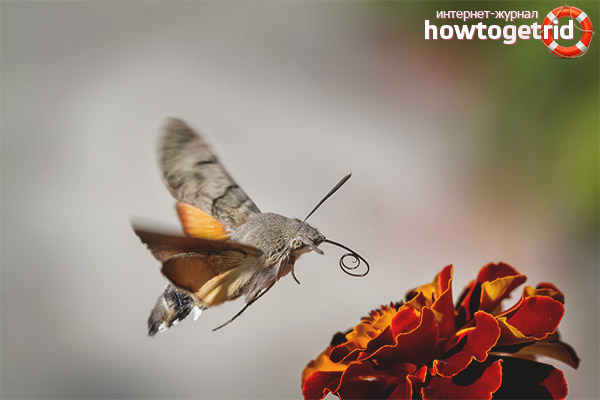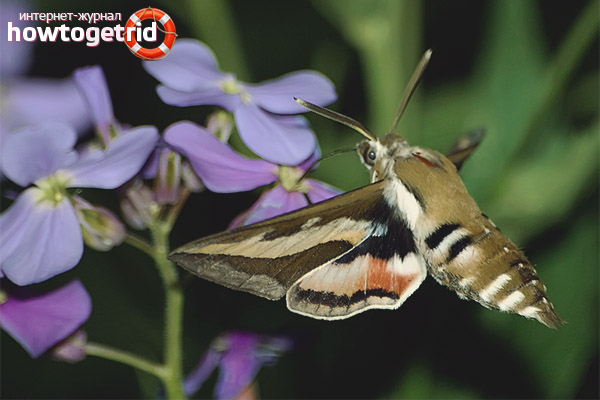The content of the article
The world of insects is vast and amazing. A special place in it is occupied by lepidoptera, otherwise butterflies, the diversity of which affects everyone: the average man, the amateur, and even the researcher. Thus, among the velvet mats and cabbage makers known to everyone there are truly exotic representatives of the class. Similar is the hawk moth. The family has such informal names as "Sphynx" or "Northern Hummingbird." The origin of the first is associated with the unusual way of eating food by the moth, the second - with the heroic dimensions of usually fragile and graceful insects.
Entomologists have identified a huge number of species of hawk moth, each of which has a distinctive color and distinctive wing pattern. You can verify this by referring to specific examples.Thus, wine hawk is the owner of exquisite burgundy wings; Deadhead hawk stands out among others due to the unique pattern on the wings and back, resembling a symbolic image of a human skull.
What is the reason for such an extensive range of color varieties of species of one family? Scientists determine this fact by the dependence of color changes on the diet and habitat of the animal. However, despite such an extensive palette, most hawk moths are decorated with a pattern, the composite elements of which are oblique stripes and large “eye” spots.
What does an insect look like?
As noted earlier, representatives of this family are large-sized individuals. Sufficient ponderability of the insect is provided by an impressive body, taking the form of a cone. Butterfly wings are partly drawn in, their span varies from 3.5 centimeters to 17.5 centimeters. Interesting characteristics can be given to the insect antennae: fairly long, pointed towards the ends, have the shape of hooks. In the upper part of the hawthorn torso there are eyes, which are topped with eyebrows formed from small scales.At a lower level in relation to the eyes is the proboscis, capable in the expanded state to reach a length that easily exceeds the size of the body of the moth. Spines on the paws of the insect also play the role of "raisin", since most butterflies cost only abundant hairline.
The hawthorn's lower body is completely covered with scales. Its elongation by means of this protective layer is interesting: by the end of the abdomen, the scales continue, thereby creating a tail. Large hawthorn wings at the front are pointed at the top. The outer edge varies: in some individuals it is predominantly even, some can boast a carved solution. Hidden rear wings smaller than the front. They are characterized by bevels and recesses at the ends.
The hawk moths often live in the crowns of trees such as birch or alder, linden or chestnut, pear or apple trees. There they appear at the end of the first summer month.
On the Internet you can find a huge number of photographs depicting hawk moths. But many users point out that digital media cannot convey the amazing beauty and unusualness with which nature has endowed this insect.
What is the lifestyle of hawk moths?
In the natural environment there are many different species of this family of lepidoptera. Their peculiarity is that each of them has its own period of the greatest activity. Some species prefer to intensify at night, the other - during the day, the third - like larks, early in the morning, the fourth - like vampires, like twilight. So it was the fate of some hawk moths that today they need protection. Therefore, many of them are listed in the Red Book.
The speed of the insect is very high. During movement in the air, it emits a specific buzz, as the moth often flaps its wings. Just imagine, in one second he manages to make fifty-two strokes. All this became the basis for comparing a hawk butterfly with a small airplane.
In appearance, large individuals easily resemble birds. Among the species whose representatives can be confused with feathered animals are, for example, the oleander hawk moth. He manages to fly over very long distances during crossings from one country to another, and from one continent to another.
Types of hawk moths
- The hawk moth. The size of its front wing is between 32 and 42 millimeters, so the wingspan can reach 8 centimeters. The carved edge of the retracted wings is the main difference of the species. The color of the wings is not uniform. First of all, it is represented by a brown background color. In addition, the wings are decorated with patterns that resemble the natural "ornament" of marble. On the back of the body of the insect is a brown stripe. The small wings behind the front are painted pinkish and red. They also contain spots, often called "eyes" for their similarity with the real eyes of animals. Being painted black, they have a ring of light blue inside. The antennae of the butterfly resemble small saws.
- Tobacco hawk. It usually lives in the tropics of the South American continent and is sometimes found by entomologists in some places in the United States of America. The insect got its name due to frequent stay on the plantations where tobacco grows. Americans call it one of the main pests of this plant.Such a conclusion is not accidental, because it is tobacco that forms the basis of the larvae ration. The caterpillars distinguished themselves by a unique pattern located on the abdominal part. It resembles a geometric pattern of twelve squares of yellow-red flowers.
- Linden hawk moth. It has an average size of the wings, providing a span of 8 centimeters. The edges of the wing are uneven, with pronounced teeth. The color of the wings is different iridescence: from orange to olive. On such a heterogeneous background, dark spots appear. The back wings of the butterfly are decorated with a contrasting strip. The color of the larvae is usually green with red stripes. The pupa, due to its location, spends the winter in the ground, is colored in brown and black. Forest forests with deciduous trees are favorable for the habitat of linden hawk moth. Therefore, species of the population can often be found in Europe, Asia Minor and the Caucasus.
What does a butterfly eat?

The favorite delicacy of insects is the nectar of flowers. During its use in food hawk moth does not sit on a flower, but flies over it, hanging in one place. This makes the butterfly look like a hummingbird known to many.The skill of such a flight has a small number of insects.
Some species of the family eat honey. Such is hawk hawk. At night, he arranges a "robbery" of hives. At first the insect flies beside it and with its buzz lulls the vigilance of bees, who take it as their own. Then it penetrates into the honey "treasury" and sucks the contents of the honeycomb.
How breed hawk moths?
The search for a partner by the female occurs with the help of the pheromones secreted by her. The resulting pair mates. This process usually takes 30 minutes, throughout its length the individuals are immobile. After that, the butterfly produces eggs, of which after 3 days the caterpillars appear. The activity of the larvae helps them prepare for the next stage. To make it happen, Nature gave the caterpillar the camouflage green color and the ability to scare away natural enemies with the help of an unpleasant smell and secreted poisons.The caterpillar carries off the accumulated energy and forces with itself into the soil, where it turns into a pupa. As such, it lives for a little more than two weeks, after which it turns into a hawk butterfly. The formed insect leaves the cocoon and dries its wings for a while. As soon as the individual realizes that it can take off, she begins to search for a partner.
Video: butterfly hawk moth (Sphingidae)












To send